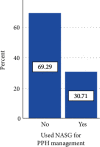Utilization of Nonpneumatic Antishock Garment and Associated Factors among Obstetric Care Providers in Public Hospitals of Sidama Region, Hawassa, Ethiopia, 2022
- PMID: 36686338
- PMCID: PMC9851775
- DOI: 10.1155/2023/6129903
Utilization of Nonpneumatic Antishock Garment and Associated Factors among Obstetric Care Providers in Public Hospitals of Sidama Region, Hawassa, Ethiopia, 2022
Abstract
Background: Nonpneumatic antishock garment is one of the newly emerging technology advances that reduce blood loss which is caused by obstetric hemorrhage and help women survive during delays to get definitive care. Over 80% of maternal mortality due to hemorrhagic shock may have been prevented if a nonpneumatic antishock garment had been utilized by an obstetric care provider. However, to the current knowledge, the utilization of nonpneumatic antishock garments is low and even no single study was conducted in the study area. Hence, we found that it is necessary to assess the magnitude and factors affecting the utilization of antishock garments among obstetric care providers in public hospitals of the Sidama region, Ethiopia, 2022.
Methods: A facility-based cross-sectional study design was employed among 403 obstetric care providers from June 15 to July 15, 2022. A two-stage sampling technique was applied; the data was collected by 5 trained BSc midwives using pretested and structured self-administered questionnaires. Data was entered into EpiData Manager version 4.6 and exported to Statistical Package for Social Sciences (SPSS) version 26 software. Bivariate and multivariable logistic regression analyses were used.
Results: A total of 394 (97.8%) health professionals participated in this study. Overall, 30.71% (95% CI: 26.4%, 35%) of the obstetric care providers had utilized nonpneumatic antishock garments for the management of postpartum hemorrhage. Training on the antishock garment (AOR = 4.183, 95% CI: 2.167, 8.075, p < 0.00), tertiary hospital (AOR = 0.355, 95% CI: 0.132, 0.952, p < 0.04), having protocol in the facility (AOR = 2.758, 95% CI: 1.269, 5.996), availability of NASG in the facility (AOR = 4.6, 95% CI: 1.603, 13.24), good knowledge (AOR = 2.506, 95% CI: 1.26, 4.984), and positive attitude (AOR = 2.381, 95% CI: 1.189, 4.766) were significantly associated factors. Conclusion and Recommendation. We found that less than one-third of the study participants have used the antishock garment in the management of postpartum hemorrhage in the current study. In addition to enhancing in-service and ongoing professional development training, it is preferable to insure the availability and accessibility of antishock in the facilities in order to close the knowledge and attitude gap among obstetric care providers.
Copyright © 2023 Merkin Bekele et al.
Conflict of interest statement
The authors report no conflicts of interest in this work.
Figures
Similar articles
-
Nonpneumatic anti-shock garment utilization for obstetric hemorrhage management and its predictors among obstetric care providers in Ethiopia: a systematic review and meta-analysis.BMC Health Serv Res. 2024 Aug 1;24(1):874. doi: 10.1186/s12913-024-11333-0. BMC Health Serv Res. 2024. PMID: 39090626 Free PMC article.
-
Utilization of non-pneumatic anti-shock garment for treating obstetric hemorrhage and associated factors among obstetric care providers in Ethiopia: A systematic review and meta-analysis.PLoS One. 2023 Nov 16;18(11):e0294052. doi: 10.1371/journal.pone.0294052. eCollection 2023. PLoS One. 2023. PMID: 37972081 Free PMC article.
-
Utilization of non-pneumatic anti-shock garment and associated factors for postpartum hemorrhage management among obstetric care providers in public health facilities of southern Ethiopia, 2020.PLoS One. 2021 Oct 28;16(10):e0258784. doi: 10.1371/journal.pone.0258784. eCollection 2021. PLoS One. 2021. PMID: 34710153 Free PMC article.
-
Knowledge, Utilization, and Associated Factors of Nonpneumatic Antishock Garments for Management of Postpartum Hemorrhage among Maternity Ward Health Care Professionals in South Wollo Zone Health Facilities, Ethiopia, 2021: A Cross-Sectional Study Design.Obstet Gynecol Int. 2023 Jan 14;2023:8247603. doi: 10.1155/2023/8247603. eCollection 2023. Obstet Gynecol Int. 2023. PMID: 36691431 Free PMC article.
-
Utilization of non-pneumatic anti-shock garment for the management of obstetric hemorrhage among healthcare providers in north Shewa zone, Ethiopia.Front Public Health. 2023 Apr 27;11:1052885. doi: 10.3389/fpubh.2023.1052885. eCollection 2023. Front Public Health. 2023. PMID: 37181723 Free PMC article.
Cited by
-
Non-pneumatic anti-shock garment utilization and associated factors in Ethiopia: a systematic review and meta-analysis.BMC Pregnancy Childbirth. 2025 Feb 20;25(1):187. doi: 10.1186/s12884-025-07299-4. BMC Pregnancy Childbirth. 2025. PMID: 39979826 Free PMC article.
-
Management of Postpartum Hemorrhage in Low- and Middle-Income Countries: Emergency Need for Updated Approach Due to Specific Circumstances, Resources, and Availabilities.J Clin Med. 2024 Dec 4;13(23):7387. doi: 10.3390/jcm13237387. J Clin Med. 2024. PMID: 39685845 Free PMC article. Review.
-
Systematic review of the barriers and facilitators to the implementation of non-pneumatic antishock garments in low- and middle-income countries: lessons for global health.BMJ Glob Health. 2025 Feb 26;10(2):e017681. doi: 10.1136/bmjgh-2024-017681. BMJ Glob Health. 2025. PMID: 40010780 Free PMC article.
-
Nonpneumatic anti-shock garment utilization for obstetric hemorrhage management and its predictors among obstetric care providers in Ethiopia: a systematic review and meta-analysis.BMC Health Serv Res. 2024 Aug 1;24(1):874. doi: 10.1186/s12913-024-11333-0. BMC Health Serv Res. 2024. PMID: 39090626 Free PMC article.
-
Utilization of non-pneumatic anti-shock garment for treating obstetric hemorrhage and associated factors among obstetric care providers in Ethiopia: A systematic review and meta-analysis.PLoS One. 2023 Nov 16;18(11):e0294052. doi: 10.1371/journal.pone.0294052. eCollection 2023. PLoS One. 2023. PMID: 37972081 Free PMC article.
References
-
- Suellen M. C. Technology solutions for global health non-pneumatic antishock garment . Johns Hopkins Bloomberg School of Public Health; 2012.
-
- FIGO Safe Motherhood and Newborn Health Committee. Corrigendum to “Non‐pneumatic anti‐shock garment to stabilize women with hypovolemic shock secondary to obstetric hemorrhage” [Int J Gynecol Obstet 128 (2015) 194–5] International Journal of Gynecology & Obstetrics . 2015;132(2):p. 245. doi: 10.1016/j.ijgo.2015.10.003. - DOI - PubMed
-
- WHO, UNICEF, UNFPA WBG and the UNPD. Trends in maternal mortality 2000 to 2017: estimates. Sexual and Reproductive Health . 2019 https://www.who.int/reproductivehealth/publications/maternal-mortality-2...
-
- MOH. Management protocol on selected obstetrics topics for hospitals . Johns Hopkins Bloomberg School of Public Health; 2020.
MeSH terms
LinkOut - more resources
Full Text Sources
Miscellaneous



